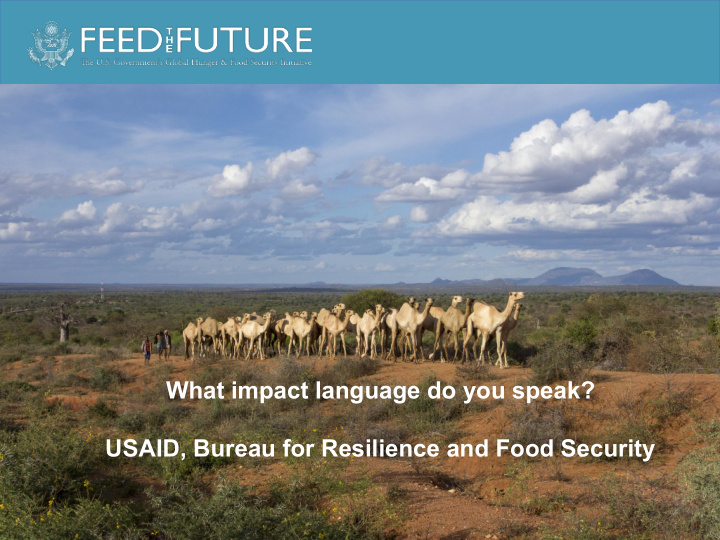



What impact language do you speak? USAID, Bureau for Resilience and Food Security 1
New Results Framework 2017 to 2021
What do we measure and how? Focus on farm-level productivity, sustainable intensification and farm profitability. We measure at two levels: • Zone of Influence level in 12 target countries (mostly sub-Saharan) -livestock module when applicable • Project level for each implementing mechanism 3
Range of standard indicators (output, outcome and impact) (using standard PIRS indicator definitions) 4 key farm level agriculture indicators : • Number of farmers applying improved management practices • Yield (production output / unit of production) (productivity) • Number of hectares under improved technologies/management practices • Value of incremental sales Context indicators (e.g. rainfall, NDVI) understand true programming impact. 4
Impact of shocks – resilience measurement Risk of Emerging Infectious Diseases Allen et al . Nature Comm. 2018
All livestock systems were treated equally - Apples and Oranges? Disaggregate livestock results by 4 production systems: • Rangelands • Rural mixed-crop • Urban-peri-urban • Intensive commercial confined systems Also gender disaggregation of data 6
AgGDP+ What’s in the “+”? Six major components (A to F), including agriculture A Farmers AgGDP+ combines Agricultural GDP (ISIC 0111-0322) F agriculture GDP and the Input suppliers Traders Imports portion of upstream and downstream sectors that B Processors Other sectors’ can linked to agricultural GDP (part of ISIC 510-990, Manufacturing GDP 1312-1520, 1701-4390, production (measured in 5811-9900) (ISIC 1010-1311, 1610-1629) C constant dollars) Consumers Traders Exports Services GDP (part of ISIC 4500-4799) D Food Services Hotels E Services GDP (ISIC 5610-5630, part of 5510-5590)
AgGDP+ / AgEMP+ Components A AgGDP+ (2017 ) Farmers 52% 50% 49% 49% F 46% Input suppliers 42% Traders 38% 38% 38% 35% 35% 32% B Processors 41% 38% 37% 31% 30% 27% 21% 21% 17% 14% 14% C 10% Traders BGD ETH GHA GTM HND KEN MLI NER NGA NPL SEN UGA D AgEMP+ (2017) Food Services Hotels 85% 81% 81% 75% 74% E 71% 58% 55% 51% 50% 51% 48% 76% 71% 70% 67% 66% 58% 41% 37% 34% 32% 33% 29% BGD ETH GHA GTM HND KEN MLI NER NGA NPL SEN UGA
Share of AgGDP+ GFSS, 2017 value chain decomposition Pulses, oilseeds Livestock, dairy Export crops Beverages, Horticulture Forestry Cereals Roots other Fish UGA 16% 12% 7% 14% 14% 6% 9% 13% 9% SEN NPL NGA NER MLI KEN HND GTM GHA ETH BGD
What is not well measured? Multifunctionality of livestock : other benefits/outputs of livestock production systems – risk management, financial services, crop- livestock synergies, ecosystem services, not captured Externalities – (GHG emissions, water footprint etc.) only captured on an ad hoc basis and by environment office (e.g. CCAFS PRIME evaluation) Food loss and waste (including mortalities and morbidities) not systematically captured 10
Milk (mt) per producing cow and per beneficiary, and number of producing cows per beneficiary 2015-2017 12.0 9.7 10.0 7.6 8.0 6.0 4.3 3.3 4.0 2.6 2.3 2.3 1.4 2.0 0.5 0.0 2015 2016 2017 Milk (mt)/producing cow Milk (mt)/beneficiary Producing cows/beneficiary
Measurement Challenges Milk (mt) per producing cow and per beneficiary, and number of producing cows per beneficiary, by sex of producer 2017 3.5 2.9 3.0 2.3 2.5 2.0 1.5 1.2 1.5 1.0 0.5 0.5 0.5 0.0 Milk yield Milk per beneficiary Cows/beneficiary Male Female
Recommend
More recommend